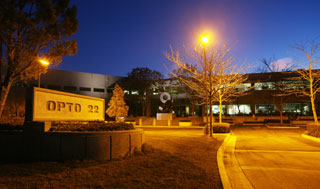Opto 22
Opto 22 is a manufacturing company specializing in hardware and software products for industrial automation, remote monitoring, and data acquisition. The company is based in Southern California and is well known in the automation and control industry for its history of innovation in the development of solid state relays and Ethernet-based input/output systems and controllers. It is based in Temecula, California.

History
Opto 22 was founded in 1974 as a manufacturer of solid state relays. The company soon expanded its offerings to include a variety of computer-based industrial automation, remote monitoring, and data acquisition products. In 1978, Opto 22 developed the first computer-based plug-in I/O modules, and created the now universally accepted Yellow-Black-White-Red color scheme used to identify digital AC input, digital AC output, digital DC input, and digital DC output modules respectively.
In 1982, the company created Optomux, a serial-based I/O system using the ASCII protocol that remains popular to this day. The following year, with the introduction of the personal computer prompting a shift in the automation industry to PC-based control, Opto 22 developed what was to be the first in a series of software packages for designing control strategies on a PC using flowcharts. This provided a new alternative to the more popular ladder logic programming model. Later, Opto 22 introduced the mistic controller, which had many of the same features and functionality of a modern programmable automation controller.
Today, Opto 22 is best known for its "SNAP" brand of Ethernet I/O products, including industrial processors, controllers, I/O racks and modules, software and accessories. In 2007 the company introduced the SNAP PAC System, unifying the aforementioned elements into a fully integrated platform, adding higher powered programmable automation controllers with redundant Ethernet communications, new programming and HMI development software, higher density I/O modules, database connectivity tools and software that simulated the SNAP PAC controller hardware. The result was a suite of control system components, suitable for simple cell control or complex, distributed control architectures.
